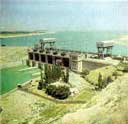Central Asia will once more have to contend with drought conditions, a United Nations Development Program (UNDP) economist said on Thursday, Central Asia Newswire reported.

- Kayrakkum reservoir
“The latest data from CAWATER show that, as of May 2011, water volumes at Uzbekistan’s Charvak and Tyuyamuyn reservoirs, but also at Tajikistan’s Kayrakkum dam were well below seasonal volumes,” the UNDP noted in its Thursday blog post penned by UNDP Senior Economist Ben Slay.
Severe drought conditions will affect the region’s cotton industry as well as rice fields, the UNDP noted. Cotton fields in Uzbekistan’s Khorezm and Karakalpakstan will be hurt by the drop in water levels, as will cotton crops in Turkmenistan’s northern Dashoguz province which borders Uzbekistan.
The drought’s effects on food crops will exacerbate rising food prices in the region. Food price inflation in the two poorest Central Asian states, Tajikistan and Kyrgyzstan, is now above 20 percent, and a scarcity of water for agricultural irrigation could cause food prices to spike higher.
Uzbekistan and Kazakhstan are also grappling with high food prices.
However, the UNDP notes that Kyrgyzstan’s Toktogul reservoir, the largest in Central Asia, is reporting higher than average water levels and may be used to top off reservoirs with low levels, the organization said.
Dropping water levels in reservoirs will also aggravate the already-dire situation in the deteriorating Aral Sea, the UNDP noted.

